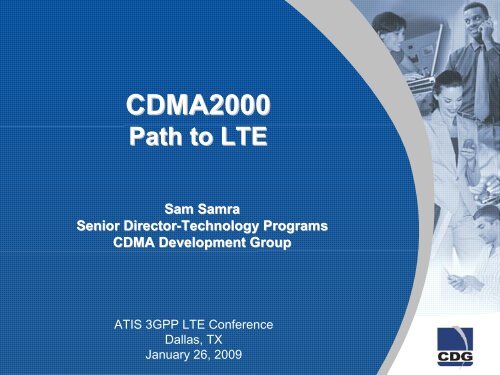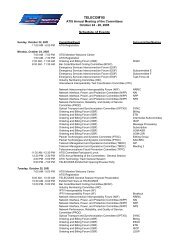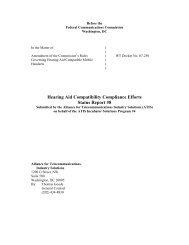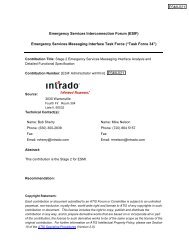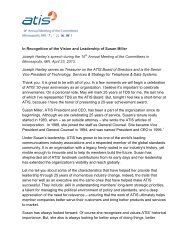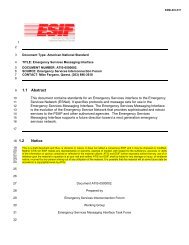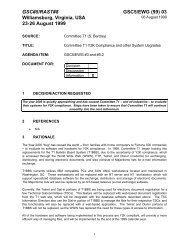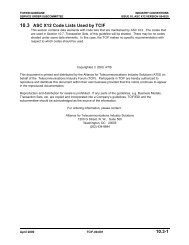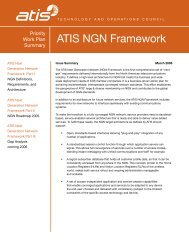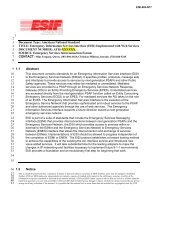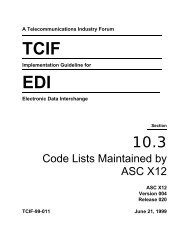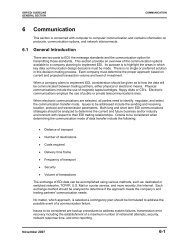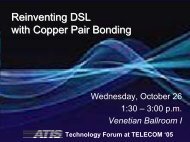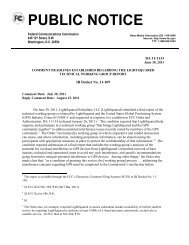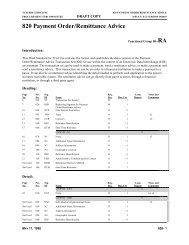You also want an ePaper? Increase the reach of your titles
YUMPU automatically turns print PDFs into web optimized ePapers that Google loves.
<strong>CDMA</strong>2000<br />
<strong>Path</strong> <strong>to</strong> <strong>LTE</strong><br />
Sam Samra<br />
Senior Direc<strong>to</strong>r-Technology Direc<strong>to</strong>r Technology Programs<br />
<strong>CDMA</strong> Development Group<br />
<strong>ATIS</strong> 3GPP <strong>LTE</strong> Conference<br />
Dallas, TX<br />
January 26, 2009
2<br />
Major Industry Initiatives<br />
www.cdg.org
2<br />
<strong>CDMA</strong>: 475 Million Global Subscribers<br />
More than 300 opera<strong>to</strong>rs in 108 countries/terri<strong>to</strong>ries have deployed<br />
or are deploying <strong>CDMA</strong>2000 ®<br />
Most leading <strong>CDMA</strong>2000 opera<strong>to</strong>rs intend <strong>to</strong> deploy <strong>LTE</strong><br />
www.cdg.org
2<br />
<strong>CDMA</strong> Subscribers as of September 2008<br />
Asia Pacific 251,010,000<br />
North America 145,800,000<br />
Caribbean & Latin America 52,150,000<br />
Europe 3,280,000<br />
Middle East 4,900,000<br />
Africa 17,620,000<br />
Total 474,760,000<br />
Caribbean & Latin America<br />
11.0%<br />
North America<br />
30.7%<br />
Europe, Middle East, Africa<br />
5.4%<br />
Asia Pacific<br />
52.9%<br />
www.cdg.org
United States: Carrier Market Share<br />
<strong>CDMA</strong>2000 is the dominant technology in the U.S. wireless services services<br />
market<br />
12%<br />
28%<br />
2<br />
Source: Chetan Sharma Consulting, August 2008<br />
U.S. Subscriber Market Share<br />
(Q3 2008)<br />
9%<br />
19%<br />
Verizon Sprint AT&T T-Mobile Others<br />
<strong>CDMA</strong> Market Share is more than 52%<br />
32%<br />
www.cdg.org
2<br />
Global <strong>CDMA</strong>2000 3G Subscriber Forecast<br />
Millions<br />
700.0<br />
600.0<br />
500.0<br />
400.0<br />
300.0<br />
200.0<br />
100.0<br />
0.0<br />
<strong>CDMA</strong>2000 Subscribers Worldwide<br />
(Cumulative)<br />
2001* 2002* 2003* 2004* 2005* 2006* 2007* 2008** 2009** 2010** 2011** 2012** 2013**<br />
<strong>CDMA</strong>2000 3.7 33.1 85.4 146.8 225.1 325.1 417.5 483.5 539.5 584.8 630.5 669.8 700.5<br />
*Source: Actual <strong>CDMA</strong> Development Group<br />
**Source: Net growth average of Strategy Analytics (Jun 2008), ABI (Aug 2008), Wireless Intelligence (Jul 2008), WCIS+ (Jul 2008),<br />
iGR (Mar 2008) and Yankee Group (Jun 2008) for subscriber forecasts (2008 and beyond) summed with CDG actual numbers of 2008<br />
www.cdg.org
Global EV-DO EV DO Broadband Subscriber Forecast<br />
Millions<br />
300.0<br />
250.0<br />
200.0<br />
150.0<br />
100.0<br />
50.0<br />
‐<br />
EV-DO EV DO Subscribers Worldwide<br />
(Cumulative)<br />
105 million people use<br />
EV-DO broadband data<br />
services offered by<br />
over 120 service providers<br />
worldwide<br />
2002* 2003* 2004* 2005* 2006* 2007* 2008** 2009** 2010** 2011** 2012** 2013**<br />
EV‐DO 0.2 4.4 12.1 24.4 55.1 90.5 116.2 150.6 180.9 219.1 259.4 293.7<br />
EV-DO EV DO created the business case for mobile broadband data services<br />
*Source: Actual <strong>CDMA</strong> Development Group<br />
**Source: 2 Net growth average of Strategy Analytics (Jun 2008), ABI (Aug 2008), Wireless Intelligence (Jul 2008), WCIS+ (Jul 2008),<br />
iGR (Mar 2008) and Yankee Group (Jun 2008) for subscriber forecasts (2008 and beyond) summed with CDG actual numbers of 2008<br />
www.cdg.org
<strong>CDMA</strong>2000: The Largest Selection of 3G Devices<br />
Over 2050 <strong>CDMA</strong>2000 devices have been introduced <strong>to</strong> the market<br />
Entry-level<br />
Voice-centric<br />
Handsets<br />
2<br />
EV-DO<br />
PC Cards<br />
* <strong>CDMA</strong>450<br />
Personal<br />
Messaging<br />
Mobile Phones<br />
EV-DO<br />
USB modems<br />
*<br />
Fixed Wireless<br />
Phones<br />
WorldMode TM<br />
Global Roaming<br />
Phones<br />
*<br />
PDAs<br />
EV-DO<br />
Fixed Wireless<br />
Terminals<br />
Television<br />
Phones<br />
Watch TV<br />
on a large screen<br />
from your<br />
mobile phone<br />
using TV Out cables<br />
Interactive<br />
Multimedia<br />
CE Devices<br />
EV-DO<br />
PCexpress<br />
Embedded Modules<br />
for PC Notebooks<br />
More than 625 EV-DO EV DO broadband data devices<br />
have been commercialized by more than 55 device suppliers<br />
*<br />
www.cdg.org
2<br />
EV-DO EV DO Rev. A Networks Worldwide<br />
The first IP-based, IP based, low-latency, low latency, advanced broadband network <strong>to</strong> be commercialized<br />
Movistar (Venezuela) Movilnet (Venezuela) Bermuda Digital Communications (BDC)<br />
MTS First Wireless (Nigeria) Arobase Telecom (Cote d’Ivoire)<br />
Tatem Telecom (Dem. Rep. of Congo)<br />
Saudi Telecom Company<br />
Telesystems or Ukraine<br />
Telesur (Suriname)<br />
Mobilkom (Czech Rep)<br />
Skytel (Mongolia)<br />
Benson Infomatics Ltd.<br />
(Tanzania)<br />
56 commercial Rev. A networks, with 34 in deployment<br />
Most <strong>CDMA</strong> opera<strong>to</strong>rs are expected <strong>to</strong> upgrade <strong>to</strong> Rev. A<br />
Logo Not Shown: Broadband Everywhere (Philippines), Itisaluna (Iraq) and MyCell Company Ltd. (Tanzania)<br />
Leap Wireless (USA) Bell Mobility (Canada)<br />
EOCG<br />
(Aruba, Cayman, Netherland Antilles)<br />
Sudatel (Sudan)<br />
Telus (Canada)<br />
IUSACELL (Mexico)<br />
Telefonica O2 (Czech Rep)<br />
BelCel JV (Belarus) CCT (British Virgin Islands) Nordisk Mobiltelefon<br />
(Norway and Sweden)<br />
Packet Communications (USA) Starcomm of Nigeria<br />
NexTech (USA)<br />
Televork (Es<strong>to</strong>nia) Etapa Cuenta (Ecuador) PT Smart Teleom (Indonesia) Movicel (Angola) G-Mobile (Mongolia) NTELOS (USA)<br />
Telkom Kenya Ltd.<br />
Delta Telecom (Russia) Neotel (South Africa) Ukranian Mobile Communications (UMC) AirVell (USA)<br />
Sferia (Poland) Speednet (Belize) Visafone (Nigeria)<br />
Itisaluna (Iraq)<br />
www.cdg.org
2<br />
EV-DO EV DO Rev. A: Value Proposition<br />
Enabling IP-based IP based “advanced advanced” mobile broadband and delay-sensitive delay sensitive services<br />
Increased speeds<br />
• Average download speeds of 600-1400 kbps with bursts up <strong>to</strong> 3.1 Mbps<br />
• Average upload speeds of 350-500 kbps with bursts up <strong>to</strong> 1.8 Mbps<br />
Increased capacity<br />
• Highest spectral efficiency available in the industry – enabling a lower <strong>to</strong>tal cost of ownership<br />
Greater bi-directional symmetry<br />
Reduced latency<br />
• Average latency below 50 msec (RTT) – enabling delay sensitive applications, such as VoIP<br />
Low connection set-up times<br />
Advanced Quality of Service (QoS)<br />
• User and Flow-based prioritization <strong>to</strong> enable different grades of service based on subscription and<br />
application<br />
IP-based network connectivity<br />
• Greater service flexibility, network control and seamless service connection<br />
• Increased efficiency driving down <strong>to</strong>tal cost savings (up <strong>to</strong> 30%)<br />
Platinum multicasting<br />
�<br />
1.5 Mbps capacity with > 98% coverage<br />
Backward compatible<br />
www.cdg.org
2<br />
EV-DO EV DO Rev B: Value Proposition<br />
Higher performance multicarrier solution with greater spectrum flexibility flexibility<br />
Aggregates multiple EV-DO channels for higher performance<br />
• Software upgrade <strong>to</strong> existing Rev A channel cards<br />
• Allows deployment in “hot-zones” with high data demand<br />
Higher broadband data rates<br />
• Peak data rates are proportional <strong>to</strong> the number of carriers aggregated<br />
– 2 RFs = 6.2 Mbps, 3 RFs = 9.3 Mbps<br />
• Typical carrier bandwidth is 5 MHz (standard supports up 20 MHz)<br />
Increased (wider) bandwidth<br />
• To support more users per sec<strong>to</strong>r or lower cost per megabyte<br />
• To encourage longer usage<br />
Network flexibility<br />
• Allocation of bandwidth for new devices depends on application needs and network availability<br />
Higher capacity<br />
• Improved spectral efficiency on both FL and RL due <strong>to</strong> multi-carrier transmissions<br />
• Better user experience throughout the cell coverage area<br />
Backward compatibility<br />
• Co-existence of 1X, Rel. 0, Rev. A and Rev. B devices in the same network<br />
• 1xEV-DO Rev A channel cards can be re-utilized<br />
www.cdg.org
Migration <strong>to</strong> Mobile Broadband is Accelerating<br />
2<br />
Migration <strong>to</strong> EV-DO EV DO is being driven by consumer demand and affordable devices<br />
Subscribers<br />
(Millions)<br />
700<br />
650<br />
600<br />
550<br />
500<br />
450<br />
400<br />
350<br />
300<br />
250<br />
200<br />
150<br />
100<br />
50<br />
0<br />
cdmaOne<br />
1X<br />
EV-DO EV DO<br />
1997 1998 1999 2000 2001 2002 2003 2004 2005 2006 2007 2008 2009 2010 2011 2012 2013<br />
Sources: Net growth average of Strategy Analytics (Jun 2008), ABI (Aug 2008), Wireless Intelligence (Jul 2008), WCIS+ (Jul 2008),<br />
iGR (Mar 2008) and Yankee Group (Jun 2008) for subscriber forecasts (2008 and beyond) summed with CDG actual numbers of 2008<br />
www.cdg.org
2<br />
<strong>LTE</strong> Subscriber Forecast<br />
Sources: ABI Research, January 2009<br />
[]<br />
<strong>LTE</strong> Subscribers by Region<br />
(Forecast: 2010 <strong>to</strong> 2013)<br />
www.cdg.org
<strong>Evolution</strong> of <strong>CDMA</strong>2000<br />
Roadmap
2<br />
Mobile Services <strong>Evolution</strong><br />
The introduction of mobile technologies is driven by the demand for new services<br />
2G 2.5G 3G Broadband<br />
GSM, TDMA,<br />
cdmaOne,<br />
PDC, PHS<br />
SMS<br />
Ring <strong>to</strong>nes<br />
IS-95B<br />
GPRS<br />
WAP<br />
Browsing<br />
MMS<br />
Source: <strong>CDMA</strong> Development Group, August 2008<br />
<strong>CDMA</strong>2000 1X<br />
W<strong>CDMA</strong><br />
Video messaging<br />
Video streaming<br />
Music downloads<br />
Location based<br />
services (LBS)<br />
1xEV-DO<br />
HSPDA<br />
Enterprise<br />
Mobile TV<br />
Music downloads<br />
Internet connectivity<br />
Advanced<br />
Broadband<br />
EV-DO Rev. A/B<br />
HSPA<br />
VoIP<br />
Video telephony<br />
Rich Multimedia<br />
M-commerce<br />
Advertising<br />
UGC and social<br />
networking<br />
Multiplayer games<br />
<strong>LTE</strong><br />
Mobile WiMAX<br />
OFDM-based<br />
Broadband<br />
<strong>CDMA</strong>-based<br />
Broadband<br />
All-IP digital<br />
convergence of<br />
services; voice,<br />
broadband access,<br />
mobile data,<br />
broadcast, etc.<br />
High-definition TV<br />
CE devices<br />
1990 1995<br />
2000<br />
2002<br />
2007-2009 2007 2009 2009…2011<br />
2009 2011<br />
Adoption of new services drives<br />
technological innovation and investments<br />
EV-DO Rev. A/B<br />
HSPA+<br />
www.cdg.org
<strong>CDMA</strong>2000 Roadmap with Next Generation<br />
<strong>CDMA</strong>2000 will continue <strong>to</strong> be enhanced <strong>to</strong> introduce new features<br />
3G <strong>CDMA</strong> <strong>Evolution</strong> <strong>Path</strong><br />
OFDMA <strong>Evolution</strong> <strong>Path</strong><br />
2001<br />
<strong>CDMA</strong>2000<br />
1X<br />
1xEV-DO<br />
Rel. 0<br />
DL: 153 kbps<br />
UL: 153 kbps<br />
DL: 2.4 Mbps<br />
UL: 153 kbps<br />
1xEV-DO<br />
Rev . A<br />
DL: 3.1 Mbps<br />
UL: 1.8 Mbps<br />
DL: 9.3 2 Mbps<br />
UL: 5.4 Mbps<br />
EV-DO<br />
Rev . B<br />
Mobile WiMAX<br />
(802.16e)<br />
FFR = 1/3/1 5<br />
DL: 35 Mbps<br />
UL: 8.2 Mbps<br />
DL: 14.7 3 Mbps<br />
UL: 5.4 Mbps<br />
2002 2003 2004 2005 2006 2007 2008 2009 2010 2011+<br />
1X Enhancements<br />
e.g., More than doubles voice capacity 1<br />
DL: 36-147 Mbps 7<br />
UL: 14-72 Mbps<br />
1<br />
Capacity increase of more than double 35 calls/sec<strong>to</strong>r is primarily due <strong>to</strong> new EVRC-B codec, UL and DL interference cancellation and mobile receive diversity<br />
2 Peak rate for 3 EV-DO carriers with software upgrade; full mobility. Standard supports up <strong>to</strong> 15 aggregated Rev. A carriers<br />
3 Peak rate for 3 EV-DO carriers with 64QAM in the DL ; full mobility. Standard supports up <strong>to</strong> 15 aggregated Rev A carriers<br />
4 EV-DO Enhancements include Fem<strong>to</strong>cell support, MIMO and 64QAM in the DL and 16 QAM in the UL <strong>to</strong> enable peak data rates shown within4 EV-DO carriers ; full mobility<br />
5 Based on Reuse = 1/3/1 FFR within 10 MHz TDD channel 2x2 MIMO ; DL:UL =2:1 ; full mobility<br />
26<br />
Based on baseline requirements; Reuse = 1/3/1 FFR within 20 MHz TDD channel 2x2 MIMO and 64QAM in DL and 1x2 MIMO and 16QAM in UL ; DL:UL =2:1 ; full mobility<br />
7 Initial baseline requirements are based on 5-20 MHz of bandwidth using OFDMA in the DL and SC-FDMA in the UL, FDD, 64QAM, 2 TX MIMO in DL, and single TX stream in UL ; full mobility<br />
VoIP<br />
<strong>LTE</strong><br />
EV-DO<br />
Enhancements<br />
e.g., DL data rates up <strong>to</strong><br />
40Mbps 4<br />
VoIP<br />
VoIP<br />
Mobile WiMAX<br />
(802.16m)<br />
FFR = 1/3/1 6<br />
DL: up <strong>to</strong> 100 Mbps<br />
UL: up <strong>to</strong> 20 Mbps<br />
www.cdg.org
2<br />
Proposed <strong>CDMA</strong>2000 1X Enhancements<br />
The voice capacity of <strong>CDMA</strong>2000 1X can be quadrupled by implementing cost<br />
effective software upgrades and selectively upgrading <strong>to</strong> a new radio radio<br />
configuration<br />
�An EVRC-B vocoder<br />
• Rx Diversity antennas<br />
• Quasi-Linear Interference Cancellation (QLIC)<br />
• Reverse Link Interference Cancellation (RL IC)<br />
• Quasi-Orthogonal Functions (QoF)<br />
• Forward and reverse link early termination<br />
• A reduced power control bit rate<br />
• Efficient closed loop power control<br />
• Smart blanking of 1/8 rate frames<br />
Note: The above is not an all inclusive list of the enhancements that are being considered by 3GPP2<br />
www.cdg.org
2<br />
Proposed EV-DO EV DO Enhancements<br />
EV-DO EV DO will be enhanced by implementing cost effective and selective upgrades<br />
• Smart Networks:<br />
• Sec<strong>to</strong>r load balancing <strong>to</strong> increase network capacity<br />
• Spatial, frequency and time domain load balancing <strong>to</strong> achieve spatial isolation<br />
• Dynamic resource management <strong>to</strong> adapt network resources <strong>to</strong> fulfill demand<br />
• Self-tuning <strong>to</strong> dynamically adjust network resources <strong>to</strong> reduce network operating costs<br />
• Smart Antennas<br />
• MIMO and RL Tx Diversity <strong>to</strong> provide higher data rates, improved cell coverage and<br />
increased sec<strong>to</strong>r capacity<br />
• Higher-order Rx Diversity and receiver enhancements designed for burst loading and<br />
interfernce <strong>to</strong> improve cell edge performance and sec<strong>to</strong>r capacity<br />
• Heterogeneous Network Deployments<br />
• Unified operation of macro cells, picos, relays and fem<strong>to</strong>cells <strong>to</strong> provide low cost network<br />
capacity and coverage<br />
• Control Channel Capacity Enhancements<br />
• New channel cards for increased spectral efficiency and multi-carrier operations<br />
Note: The above is not an all inclusive list of the enhancements that are being considered by 3GPP2 WG 3<br />
www.cdg.org
<strong>CDMA</strong> and OFDM are complementary technologies<br />
2<br />
Wider-bandwidth<br />
OFDM-based broadband networks<br />
will complement 3G <strong>CDMA</strong><br />
Backhaul Broadcast<br />
WiMAX 802.16d<br />
MFLO<br />
DVB-H<br />
ISDB-T<br />
TDMB<br />
S-DMB<br />
CMMB<br />
Additional<br />
Broadband<br />
Capacity<br />
<strong>LTE</strong><br />
Mobile WiMAX<br />
WiFi<br />
CDG is enabling interoperability between all these technologies<br />
<strong>to</strong> ensure a seamless user experience<br />
www.cdg.org
<strong>CDMA</strong>2000 and <strong>LTE</strong><br />
Network Interoperability
2<br />
Requirements for Mobility and HO<br />
<strong>CDMA</strong>2000 and <strong>LTE</strong> connected systems…<br />
�<br />
�<br />
�<br />
�<br />
�<br />
Shall support terminals with single radio and dual radio solutions.<br />
Shall support voice service continuity between access networks.<br />
Shall support bidirectional service continuity between access networks <strong>to</strong><br />
enable both best effort and real-time applications.<br />
Shall minimize impact on service quality, e.g. Quality of Service (QoS),<br />
reduce interruption times.<br />
Should minimize the coupling between access networks (e.g. by using<br />
transparent signaling through the source system) allowing independent<br />
pro<strong>to</strong>col evolution in each access.<br />
� Shall be based on the principles of network controlled radio access mobility.<br />
www.cdg.org
2<br />
Core Network Architecture<br />
The Interworking architecture must cover:<br />
�<br />
�<br />
�<br />
�<br />
Mobility<br />
Authentication / Security<br />
Policy and Charging<br />
Fixed / Mobile convergence<br />
Current agreed architectures for OFDM-<strong>CDMA</strong><br />
Interworking<br />
�<br />
EV-DO (HRPD) � <strong>LTE</strong>: based on 3GPP Evolved Packet Core (EPC)<br />
(agreed in 3GPP and 3GPP2)<br />
Common Reference Architecture <strong>to</strong> Accommodate Performance<br />
Requirements and Deployment Models for all Technology Pairings<br />
www.cdg.org
2<br />
Inter-system Inter system Functionalities<br />
Loose coupling<br />
a) “Break Before Make”<br />
(MBB)<br />
b) “Dual-radio MBB”<br />
Tight coupling<br />
“Make Before Break”<br />
“Network-controlled”<br />
Little or no inter-system functionalities<br />
UE-centric L3 mobility based on (P)MIP<br />
Resources are released in the source system prior <strong>to</strong><br />
Handover execution<br />
Service break is significant<br />
Resources in target system are obtained prior <strong>to</strong> HO<br />
execution directly over target radio interface -<br />
“seamless mobility”<br />
Requires dual radio capability, simultaneous transmit.<br />
Requires inter-system functionalities<br />
Network-controlled; L3 mobility based on (P)MIP (S101)<br />
Ability <strong>to</strong> configure and report measurements of the<br />
target system<br />
Inter-system interface for establishing resources in<br />
target system prior <strong>to</strong> HO execution<br />
Possibility of data forwarding<br />
Suitable for single radio devices, but also applicable<br />
<strong>to</strong> dual radio devices<br />
www.cdg.org
2<br />
3GPP2 and 3GPP Evolved Packet Core<br />
(Example of Roaming Arch in TS 23.402)<br />
HPLMN<br />
3GPP<br />
Access<br />
VPLMN<br />
Non-3GPP<br />
Networks<br />
Serving<br />
Gateway<br />
EV-DO is considered<br />
a Trusted Non-3GPP<br />
Access Technology<br />
S6a<br />
Gxc<br />
S8<br />
S2a<br />
Trusted<br />
Non-3GPP<br />
Access<br />
HSS<br />
Gxa<br />
PDN<br />
Gateway<br />
S2b<br />
Gx<br />
hPCRF<br />
S9<br />
vPCRF<br />
Gxb<br />
ePDG<br />
SWn<br />
Rx<br />
SGi<br />
S6b<br />
Non-trusted<br />
Non-3GPP<br />
Access<br />
SWx<br />
Opera<strong>to</strong>r’s IP<br />
Services<br />
(e.g. IMS, PSS etc.)<br />
SWm<br />
SWa<br />
3GPP AAA<br />
Server<br />
SWd<br />
3GPP AAA<br />
Proxy<br />
STa<br />
www.cdg.org
2<br />
DO (HRPD) and <strong>LTE</strong> Interworking<br />
Responsible Groups E-UTRAN (<strong>LTE</strong>)/HRPD - Work item 195<br />
TSG-S HRPD/1xRTT and <strong>LTE</strong> Interworking and<br />
Inter-Technology Handoff-Stage 1<br />
S.R0129-0 v1.0 (Published)<br />
TSG-A E-UTRAN <strong>to</strong> HRPD Handoffs-IOS<br />
(A.S0022) (TIA-1142)-expected <strong>to</strong> be<br />
approved in December/January<br />
TSG-X X.P0057 in V&V<br />
TSG-C Interworking of 1X, HRPD and <strong>LTE</strong> -<br />
C.S0087 in V&V<br />
www.cdg.org
2<br />
Principles for Optimised Handovers<br />
Inspired from the A21 interface defined for EV-DO => 1X voice call<br />
continuity<br />
Terminal interacts directly with target system (<strong>LTE</strong> or EV-DO) <strong>to</strong> perform<br />
handover preparation<br />
Source system provides “tunneling” capability (S101) for terminal <strong>to</strong><br />
interact with target system<br />
In the <strong>LTE</strong> => EV-DO direction there are two distinct steps<br />
1) Pre-registration: when conditions are such that a handover <strong>to</strong> HRPD may be required, the<br />
source system provides the UE with sufficient information <strong>to</strong> perform pre-registration with the<br />
target HRPD access and core network, over the S101 tunnelling interface<br />
2) HO execution: if conditions subsequently warrant that a handover should occur, the handover<br />
signalling will also be performed over the S101 tunnelling interface, whereas data forwarding<br />
takes place on S103<br />
Similar logic applies in the EV-DO => <strong>LTE</strong> direction<br />
� Except that, pre-registration also triggers the HO execution<br />
www.cdg.org
2<br />
Voice Continuity with Legacy CS Domain:<br />
OFDM <strong>to</strong> Circuit Switch (CS) Handoff (HO)<br />
EPC/<strong>LTE</strong> is Packet Switched (PS) only system<br />
Voice continuity between <strong>LTE</strong> and 1X Circuit Switched (CS) domain<br />
requires a transformation of a VoIP (on IMS) call in<strong>to</strong> CS session and<br />
vice versa<br />
Requirement is that there should be minimum impact on the CS domain<br />
The solution <strong>to</strong> the problem falls in the Voice Call Continuity (VCC) with<br />
“single radio hybrid terminal” category<br />
� VCC = Voice Call Continuity between CS domain and PS via IMS<br />
� Because of the similarities with 3GPP2 VCC and 3GPP Rel-7 VCC, the<br />
problem is referred <strong>to</strong> as Single Radio VCC<br />
� Single Radio VCC for <strong>LTE</strong>-1X is specified in 3GPP TS 23.216<br />
www.cdg.org
2<br />
Graceful <strong>CDMA</strong> <strong>to</strong> <strong>LTE</strong> <strong>Evolution</strong><br />
Standards alignment, driven by service providers<br />
<strong>CDMA</strong>2000 core networks with IMS and VCC will play a key role in<br />
expanding 3G and 4G deployments<br />
�<br />
�<br />
e.g. Seamless call handoffs between 2G, 3G and 4G networks<br />
e.g. EV-DO and <strong>LTE</strong> fem<strong>to</strong>cells<br />
<strong>CDMA</strong>2000 opera<strong>to</strong>rs are among the first <strong>to</strong> deploy wider-bandwidth<br />
OFDM solutions:<br />
�<br />
�<br />
Broadcast – DVB-H, MFLO, ISDB-T, T-DMB, CMMB, etc.<br />
Additional broadband capacity – <strong>LTE</strong>, Wi-Fi, etc.<br />
<strong>CDMA</strong> Ecosystem will ensure service continuity will exist between these<br />
complementary solutions<br />
IP Core Networks and VCC Bridge Multiple Technologies,<br />
including Wi-Fi, Fem<strong>to</strong>, <strong>LTE</strong> and Mobile WiMAX<br />
www.cdg.org
<strong>CDMA</strong>2000 and <strong>LTE</strong><br />
Device Interoperability
Next Generation Multimode Devices<br />
Next generation mobile broadband devices will leverage the learning learning<br />
curve of<br />
<strong>CDMA</strong>2000 WorldMode TM devices<br />
EV-DO Rev A<br />
HSPA<br />
1X<br />
GSM/GPRS<br />
GPS<br />
<strong>LTE</strong><br />
WiMAX*<br />
EV-DO Rev. B<br />
EV-DO Rev. A<br />
EV-DO Rel. 0<br />
GPS<br />
1X<br />
Radio Frequency Links:<br />
<strong>LTE</strong><br />
WiMAX*<br />
HSPA<br />
EV-DO Rev. B<br />
EV-DO Rev. A<br />
EV-DO Rel. 0<br />
GPS<br />
1X<br />
450 MHz 700 MHz 800 MHz 900 MHz 1500 MHz GPS 1700 MHz 1800 MHz<br />
1900 MHz AWS 2100 MHz 2500 MHz 3500 MHz<br />
<strong>CDMA</strong>2000 opera<strong>to</strong>rs will be among the first opera<strong>to</strong>rs <strong>to</strong> offer<br />
next generation mobile broadband services<br />
* WiMAX is enabled using a separate chipset<br />
** 2 MDM 9800 and MDM 9600 chipsets will support FDD and TDD duplex modes and different carrier bandwidths. RF links included<br />
will be dependent upon the carrier’s requirements<br />
www.cdg.org
Conclusion<br />
• EV-DO EV DO Rev. A is creating and validating the business case for next<br />
generation mobile broadband technologies<br />
• <strong>CDMA</strong>2000 networks will be complemented by and interoperate with<br />
<strong>LTE</strong> <strong>to</strong> provide additional broadband access capacity and performance<br />
• <strong>CDMA</strong>2000 interworking with <strong>LTE</strong> will be enabled by:<br />
• Common Core Network Architecture – 3GGP/3GPP2 Evolved Packet Core<br />
• Hand-off control and Voice Call Continuity with <strong>CDMA</strong>2000 1X<br />
• <strong>CDMA</strong>2000 and <strong>LTE</strong> WorldMode TM devices<br />
• EV-DO EV DO Rev. A/B will provide a seamless user experience as <strong>LTE</strong><br />
networks are built-out over time<br />
• <strong>CDMA</strong>2000 opera<strong>to</strong>rs will among the first <strong>to</strong> deploy <strong>LTE</strong><br />
• Without having <strong>to</strong> deploy a GSM/W<strong>CDMA</strong> network<br />
• <strong>CDMA</strong>2000 learning curve will drive <strong>LTE</strong> penetration with affordable<br />
2 WorldMode devices<br />
www.cdg.org


